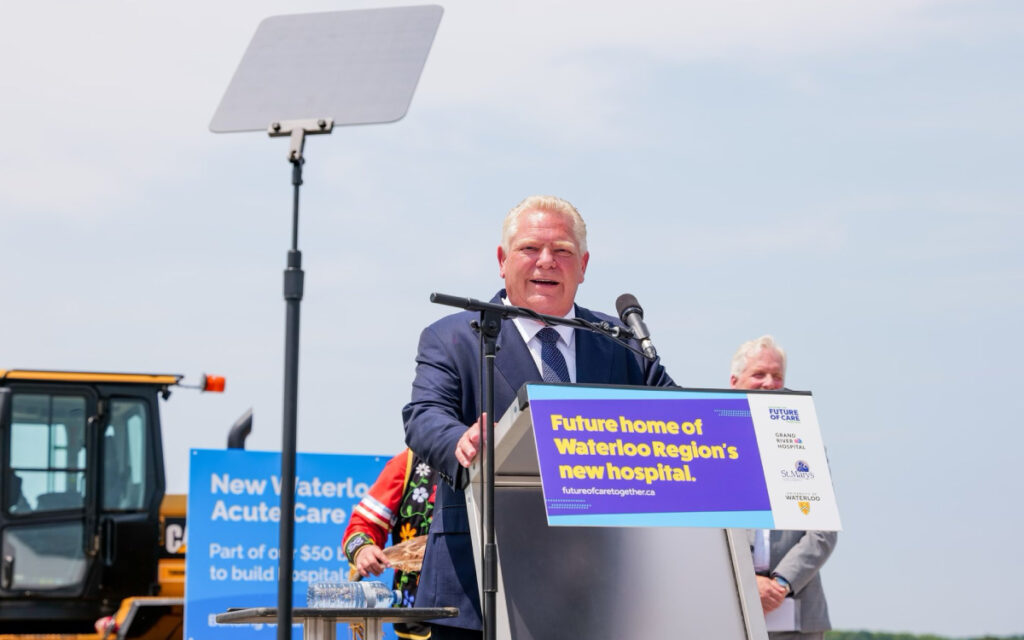
The extra almost $5 million in additional funding brings the province’s total investment in Hamilton ambulance services to over $35.5 million this year. Pictured: Premier Doug Ford. Photo Credit: Doug Ford/X.
In an effort to reduce ambulance offload times in the City of Hamilton, the Ontario government announced that they are increasing paramedic funding by 16 per cent for 2024.
The extra 16 per cent, which translates to almost $5 million in additional funding, brings the province’s total investment in Hamilton ambulance services to over $35.5 million this year.
The Government of Ontario is also investing an additional $2.7 million through the Dedicated Offload Nurses Program to hire more nurses and other health professionals dedicated to offloading ambulance patients at hospital emergency departments.
That investment allows paramedics to get back onto the road faster to respond to their next call.
The province says that the program has “played a significant role in reducing ambulance offload times and increasing ambulance availability for 9-1-1 patients across the province.”
The government says that “as a result of the investment and the dedication of health care professionals provincial ambulance offload time has been reduced by more than 50 per cent since its peak in October 2022.”
Donna Skelly, who serves as Member of Provincial Parliament (MPP) for the Hamilton-based riding of Flamborough-Glanbrook, said, “Our government continues to make investments that connect people to the care they need more efficiently.”
“This funding will help address increased costs so that our health care professionals can continue to deliver high-quality emergency care in our community.”
Neil Lumsden, MPP for Hamilton East-Stoney Creek, echoed Skelly.
“Our ambulance services help save lives, and reducing offload times means that paramedics can get back out in the community more quickly,” he said.
“That’s why I’m proud that our government has increased funding to Hamilton’s ambulance services by nearly $5 million and is providing $2.7 million for the Dedicated Offload Nurses Program. This investment will ensure that people can continue to get the care they need, when they need it,” Lumsden added.
The Government of Ontario is also continuing to implement a new system to better prioritize and triage emergency medical calls and dispatch paramedics.
The system, called the Medical Priority Dispatch System (MPDS), has already been rolled out in Mississauga, Kenora, Thunder Bay, Ottawa, and Renfrew, and the province is accelerating its implementation at the 15 remaining dispatch sites across Ontario.
The system will be implemented at those last sites over a year ahead of schedule.
MPDS is a set of standardized protocols to triage patients over the phone when they call 9-1-1.
The protocols include vital questions to ask the caller, pre-arrival instructions to provide to the caller, and dispatch priorities for paramedics.
Dispatchers are then better able to categorize calls and provide paramedics with information as to whether they need to respond as fast as possible with lights and sirens or in a more routine manner.

Based in Hamilton, he reaches hundreds of thousands of people monthly on Facebook, Instagram, TikTok, and Twitter. He has been published in The Hamilton Spectator, Stoney Creek News, and Bay Observer. He has also been a segment host with Cable 14 Hamilton. In 2017, he received the Chancellor Full Tuition Scholarship from the University of Ottawa (BA, 2022). He has also received the Governor General’s Academic Medal. He formerly worked in a non-partisan role on Parliament Hill in Ottawa.






